Don Mammoser heads to Southeast Asia to photograph native wildlife with his Tamron SP 150-600mm VC G2 lens.
Don Mammoser spent much of 2011 and 2012 on the adventure of a lifetime: traveling the world and taking pictures along the way. One of the stops on his itinerary was Southeast Asia’s island of Borneo, and it stood out so much that Don decided to head back to lead a photography tour there last October.
“It’s a fantastic destination for wildlife photos,” he says. “I went on a 14-day tour with four clients, plus my wife, to the Malaysian part of Borneo. Our primary goal was to photograph primates, like monkeys and orangutans, but we were also graced with several other species of animals. In some parts we visited, we photographed in sanctuaries, where the monkeys would run right up to you. In other, more rustic parts, we were taken out on the water by guides in motorboats to photograph wildlife along the banks of the river.”
Don brought along his Tamron SP 150-600mm VC G2 lens to capture the resident creatures. “What an awesome, versatile lens,” he says. “I see people struggle with single focal-length lenses while photographing wildlife, and then when the animal comes too close, they’re out of luck. All I have to do is pull back to the 150mm end and start taking pictures. Plus, the autofocus is incredibly fast, it’s very lightweight—I’ve got a strap system where I just hang it upside-down at my waist—and the Vibration Compensation (VC) feature is seamless when it kicks on. My photos come out sharp even handheld in challenging lighting conditions.”
Although they took pictures from sunrise to sunset, Don’s group found mornings proved best for their photographic forays. “The earliest part of the day is when the wildlife is hungry and looking for food,” he says. “They’ve rested and are ready to be active. All the species here wake up early like we do and want to get their morning coffee, so to speak.”
With its overcast days and tree cover, Borneo’s rainforests typically offered consistent, even lighting for Don to work with. “Not every day was cloudy, though,” Don says. “On sunny days, for example, I was able to capture photos that added rim lighting onto my subjects, which made them pop in my images a bit more. If it was really sunny and harsh, however, I’d try to minimize the amount of background I was showing by zooming in close to 600mm and creating a portrait instead.”

350mm, F/6.3, 1/80th sec.
A group of macaques that Don managed to photograph, however, wasn’t close to the lodge, but on a nearby beach, hunting for crabs. “It was raining when I took this shot, and they were huddled on top of a wood platform,” he says. “But even though it was raining, there were still some bright areas in the sky—enough to give this mother and baby just a little rim lighting.”
Many of the species on Borneo are extremely friendly, which makes for fun, accessible photo ops. “Proboscis monkeys come very close to people,” Don says. “I’m talking within 3 or 4 feet. There’s a small boardwalk at Labuk Bay, another sanctuary we were at, that heads out into a mangrove forest, and the monkeys would sit on the railing of that boardwalk while we stood right next to them and snapped a photo.”
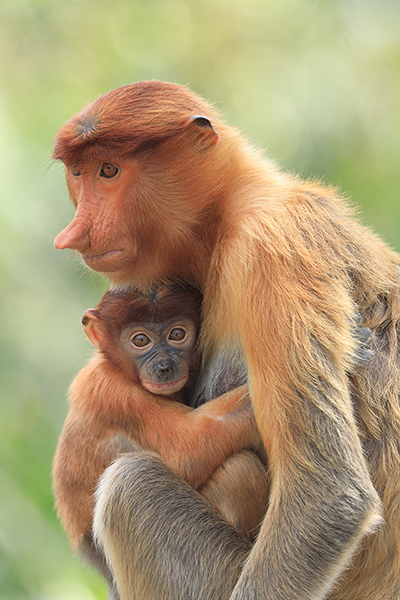
483mm, F/8, 1/160th sec.
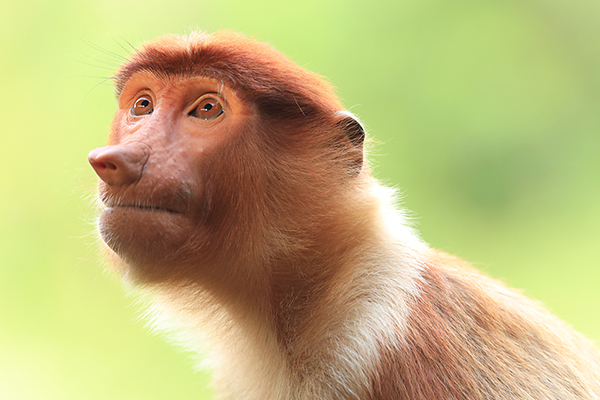
500mm, F/8, 1/50th sec.

428mm, F/8, 1/200th sec.

158mm, F/8, 0.6 sec.
Don had already observed the pig a few times, so he was ready one night when the pig wandered over. “I knew I had to get my tripod, because it was still dark, even with the outside lights on,” he says. “I headed over there right as the sun set, when you could still see the light from the horizon, and the lights from the restaurant were just lighting up the grass the pig was stretched out on. Using a long shutter speed enabled me to get this shot. All that detail you can see on the pig is a testament to the sharpness of the 150-600 lens.”
Don also strives to show the intimacy and relationships between animals when he’s photographing them. “I love to show that interaction,” he says. “As observers of nature and wildlife, it offers us the perspective of, ‘OK, they have a world all their own.’ And you can clearly see the emotion on their faces. By showing interactions between two or more animals, you get an even deeper sense of what they’re all about.”
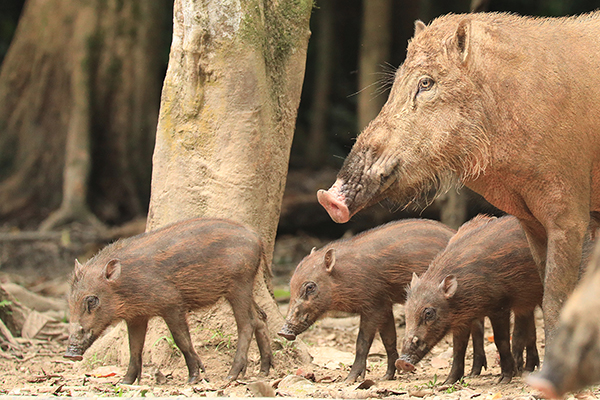
309mm, F/7.1, 1/320th sec.
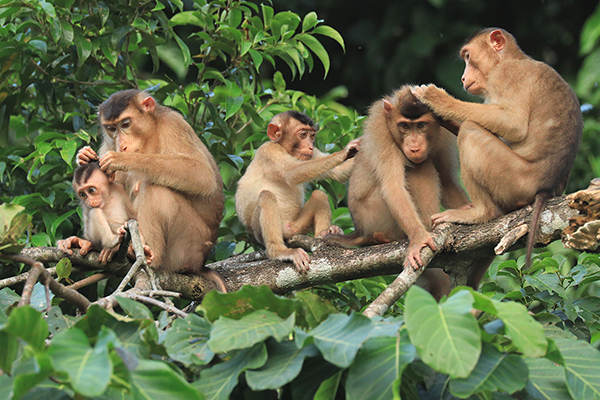
450mm, F/7.1, 1/250th sec.
The boatman was able to maneuver their vessel into an optimal picture-taking position: almost at the macaques’ level, just directly across from them, with nothing in between but five or 10 feet of water. “They felt safe, because we were still aways across the water, and we felt like we could photograph as much as we wanted to without disturbing them,” Don says.
Because he was handholding his camera, as were the other photographers on board, it was critical for Don to switch on the Vibration Compensation (VC) feature on his lens. “There’s always movement when you’re on a boat, even when you’re in calm water like a river,” he says. “There’s always someone or something moving. But the VC ability on this lens allowed me to get an extra two or three stops from what I’d normally get, which means my images came out super-sharp.”
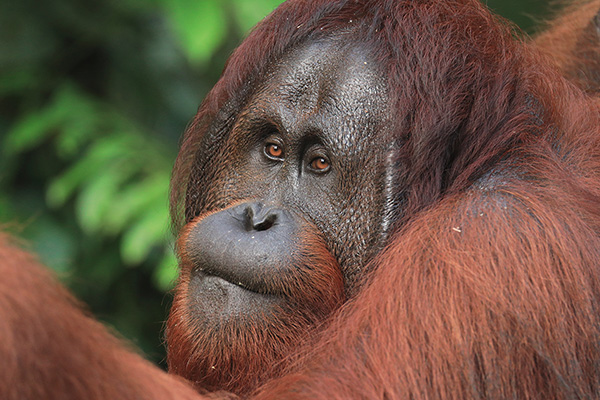
600mm, F/8, 1/250th sec.
Don was photographing a couple of orangutans at the Semenggoh Nature Reserve, a sanctuary in the southern part of Malaysian Borneo, when one of the park rangers ushered them to check out a giant male named Richie. “These animals can weigh up to 220 pounds,” Don says. “This one may not have weighed that much, but he was pretty big—he had a 6-foot arm span. He had impressively long, orange hair, and there was such a presence about him.”
The sharpness of the 150-600 allowed Don to capture every last detail on the orangutan’s face, right down to the droplets of sweat on his brow. “When you’re in the tropics and there’s 95 percent humidity, you’re going to sweat,” he says. “The orangutans sweat just like we do.”
Although these primates need a lot of prime rainforest habitat to survive, Don is hopeful for their future now that humans are becoming increasingly aware of their value, and their predicament. “Hopefully they’ll be around for quite some time,” he says. “It’s a really special feeling to be near a wild orangutan like that, and the 150-600 allowed me to capture the perfect portrait.”
To see more of Don Mammoser’s work, go to www.donmammoserphoto.com. Don will also be leading a tour to Borneo in 2019; check out www.donmammoserphoto.com/borneo-tour.html for more info.
